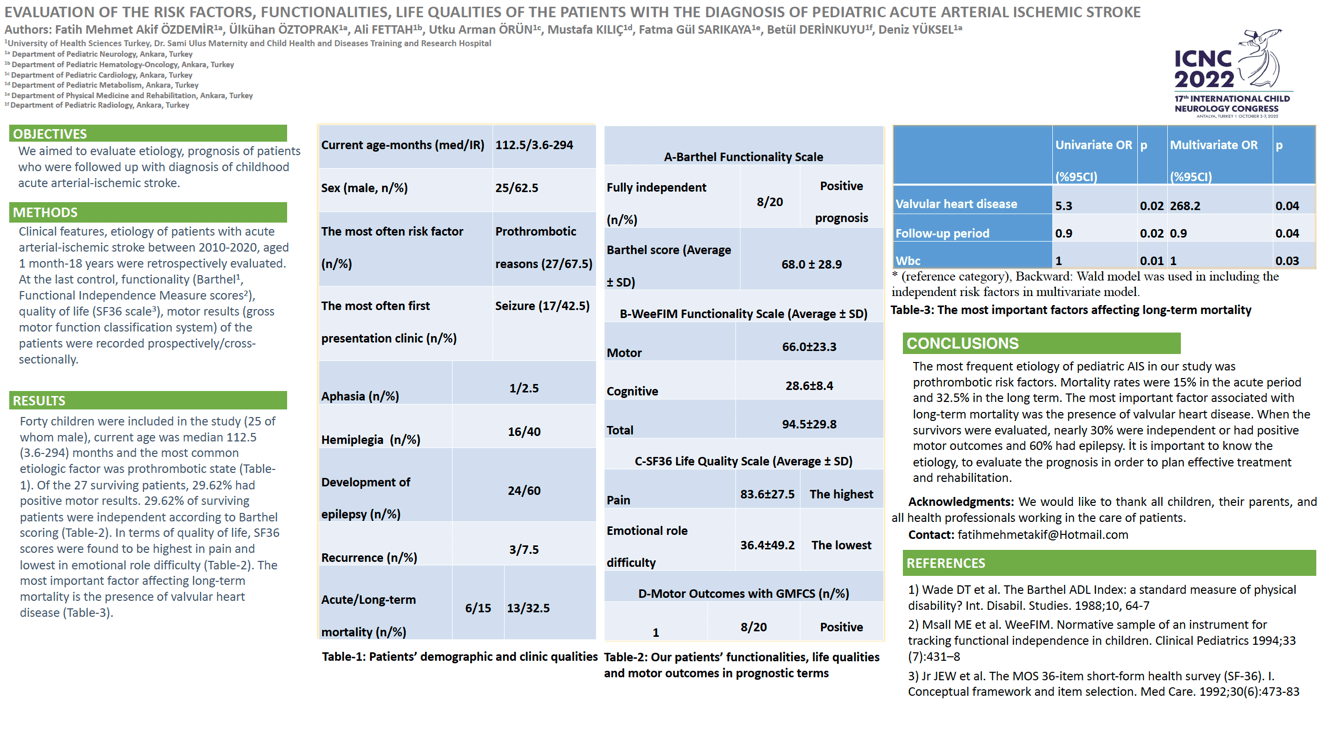EVALUATION OF THE RISK FACTORS, FUNCTIONALITIES, LIFE QUALITIES OF THE PATIENTS WITH THE DIAGNOSIS OF PEDIATRIC ACUTE ARTERIAL ISCHEMIC STROKE
Fatih Mehmet Akif ÖZDEMİR, Ülkühan ÖZTOPRAK, Ali FETTAH, Utku Arman ÖRÜN, Mustafa KILIÇ, Fatma Gül SARIKAYA, Betül DERİNKUYU, Deniz YUKSEL
Objectives: To evaluate etiology, prognosis of patients who were followed up with diagnosis of childhood acute arterial-ischemic stroke. Methods: Clinical features, etiology of patients with acute arterial-ischemic stroke between 2010-2020, aged 1 month-18 years were retrospectively evaluated. At the last control, functionality (Barthel1, WeeFIM2 scores), quality of life (SF36 scale3), motor results (gross motor function classification system) of the patients were recorded prospectively/cross-sectionally. Results: Forty children were included in the study (25 of whom male), current age was median 112.5 (3.6-294) months and the most common etiologic factor was prothrombotic state (Table-1). Of the 27 surviving patients, 29.62% had positive motor results. 29.62% of surviving patients were independent according to Barthel scoring (Table-2). In terms of quality of life, SF36 scores were found to be highest in pain and lowest in emotional role difficulty (Table-2). The most important factor affecting long-term mortality is the presence of valvular heart disease (Table-3, Table-4). Conclusions: İt is important to know the etiology, to evaluate the prognosis in order to plan effective treatment and rehabilitation.
References: 1) Wade DT et al. The Barthel ADL Index: a standard measure of physical disability? Int. Disabil. Studies. 1988;10, 64-7 2) Msall ME et al. WeeFIM. Normative sample of an instrument for tracking functional independence in children. Clinical Pediatrics 1994;33 (7):431–8 3) Jr JEW et al. The MOS 36-item short-form health survey (SF-36). I. Conceptual framework and item selection. Med Care. 1992;30(6):473-83
Keywords: pediatrics, acute arterial ischemic stroke, etiology, risk factors, prognosis
Fatih Mehmet Akif ÖZDEMİR
University of Health Sciences Turkey, Dr. Sami Ulus Maternity and Child Health and Diseases Training and Research Hospital, Ankara
Turkey
Ülkühan ÖZTOPRAK
University of Health Sciences Turkey, Dr. Sami Ulus Maternity and Child Health and Diseases Training and Research Hospital, Ankara
Turkey
Ali FETTAH
University of Health Sciences Turkey, Dr. Sami Ulus Maternity and Child Health and Diseases Training and Research Hospital, Ankara
Turkey
Utku Arman ÖRÜN
University of Health Sciences Turkey, Dr. Sami Ulus Maternity and Child Health and Diseases Training and Research Hospital, Ankara
Turkey
Mustafa KILIÇ
University of Health Sciences Turkey, Dr. Sami Ulus Maternity and Child Health and Diseases Training and Research Hospital, Ankara
Turkey
Fatma Gül SARIKAYA
University of Health Sciences Turkey, Dr. Sami Ulus Maternity and Child Health and Diseases Training and Research Hospital, Ankara
Turkey
Betül DERİNKUYU
University of Health Sciences Turkey, Dr. Sami Ulus Maternity and Child Health and Diseases Training and Research Hospital, Ankara
Turkey
Deniz YUKSEL
University of Health Sciences Turkey, Dr. Sami Ulus Maternity and Child Health and Diseases Training and Research Hospital, Ankara
Turkey
Objectives: To evaluate etiology, prognosis of patients who were followed up with diagnosis of childhood acute arterial-ischemic stroke. Methods: Clinical features, etiology of patients with acute arterial-ischemic stroke between 2010-2020, aged 1 month-18 years were retrospectively evaluated. At the last control, functionality (Barthel1, WeeFIM2 scores), quality of life (SF36 scale3), motor results (gross motor function classification system) of the patients were recorded prospectively/cross-sectionally. Results: Forty children were included in the study (25 of whom male), current age was median 112.5 (3.6-294) months and the most common etiologic factor was prothrombotic state (Table-1). Of the 27 surviving patients, 29.62% had positive motor results. 29.62% of surviving patients were independent according to Barthel scoring (Table-2). In terms of quality of life, SF36 scores were found to be highest in pain and lowest in emotional role difficulty (Table-2). The most important factor affecting long-term mortality is the presence of valvular heart disease (Table-3, Table-4). Conclusions: İt is important to know the etiology, to evaluate the prognosis in order to plan effective treatment and rehabilitation.
References: 1) Wade DT et al. The Barthel ADL Index: a standard measure of physical disability? Int. Disabil. Studies. 1988;10, 64-7 2) Msall ME et al. WeeFIM. Normative sample of an instrument for tracking functional independence in children. Clinical Pediatrics 1994;33 (7):431–8 3) Jr JEW et al. The MOS 36-item short-form health survey (SF-36). I. Conceptual framework and item selection. Med Care. 1992;30(6):473-83
Keywords: pediatrics, acute arterial ischemic stroke, etiology, risk factors, prognosis
Fatih Mehmet Akif ÖZDEMİR
University of Health Sciences Turkey, Dr. Sami Ulus Maternity and Child Health and Diseases Training and Research Hospital, Ankara
Turkey
Ülkühan ÖZTOPRAK
University of Health Sciences Turkey, Dr. Sami Ulus Maternity and Child Health and Diseases Training and Research Hospital, Ankara
Turkey
Ali FETTAH
University of Health Sciences Turkey, Dr. Sami Ulus Maternity and Child Health and Diseases Training and Research Hospital, Ankara
Turkey
Utku Arman ÖRÜN
University of Health Sciences Turkey, Dr. Sami Ulus Maternity and Child Health and Diseases Training and Research Hospital, Ankara
Turkey
Mustafa KILIÇ
University of Health Sciences Turkey, Dr. Sami Ulus Maternity and Child Health and Diseases Training and Research Hospital, Ankara
Turkey
Fatma Gül SARIKAYA
University of Health Sciences Turkey, Dr. Sami Ulus Maternity and Child Health and Diseases Training and Research Hospital, Ankara
Turkey
Betül DERİNKUYU
University of Health Sciences Turkey, Dr. Sami Ulus Maternity and Child Health and Diseases Training and Research Hospital, Ankara
Turkey
Deniz YUKSEL
University of Health Sciences Turkey, Dr. Sami Ulus Maternity and Child Health and Diseases Training and Research Hospital, Ankara
Turkey

Fatih Mehmet Akif ÖZDEMİR
University of Health Sciences Turkey, Dr. Sami Ulus Maternity and Child Health and Diseases Training and Research Hospital, Ankara Turkey
University of Health Sciences Turkey, Dr. Sami Ulus Maternity and Child Health and Diseases Training and Research Hospital, Ankara Turkey